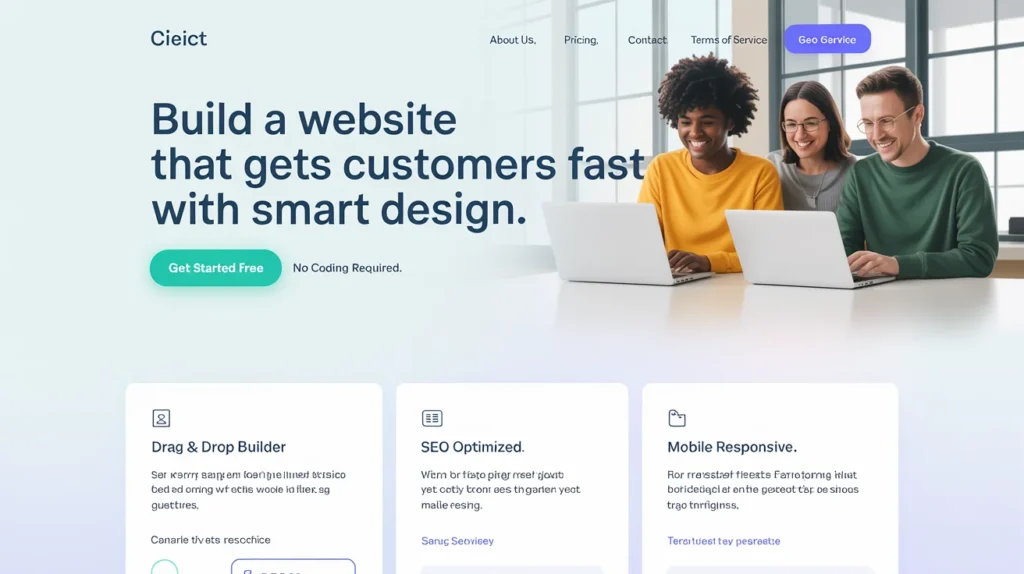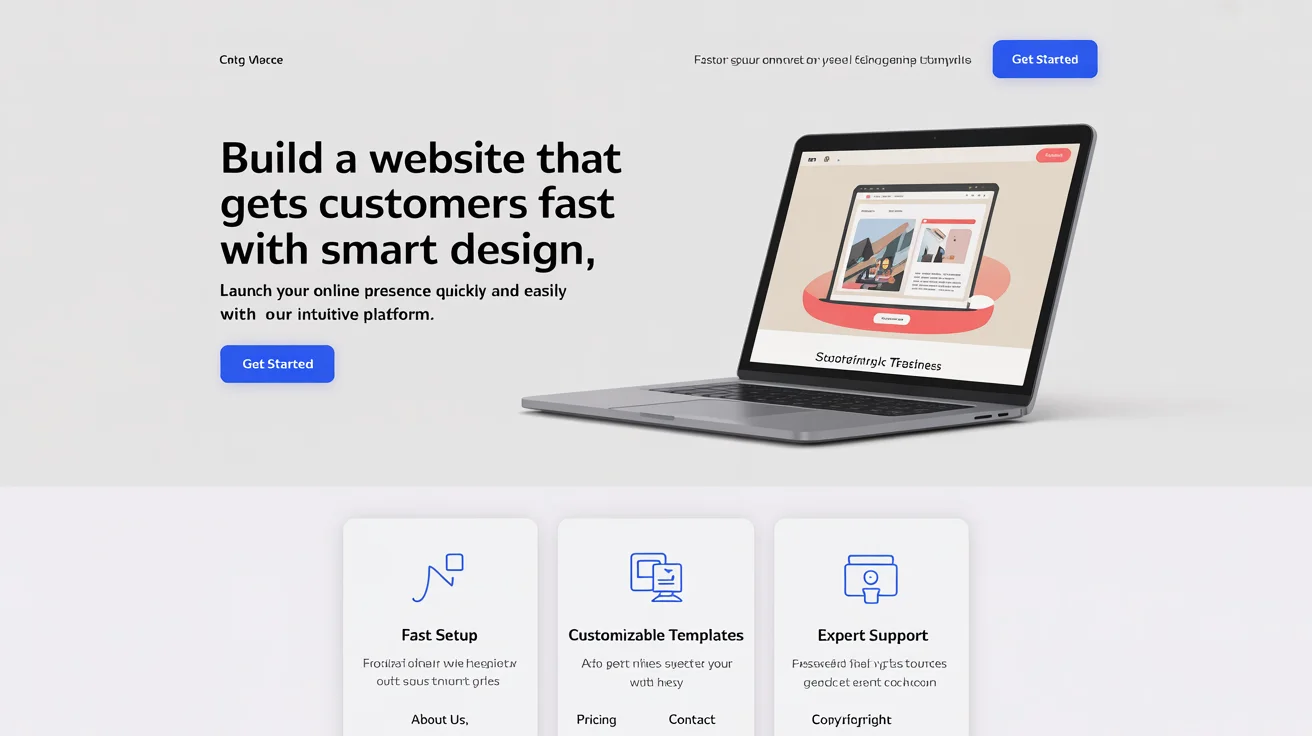Building a website that gets customers is essential for any business aiming to grow online. A website is more than just an online presence; it’s a powerful tool that can attract visitors, convert them into customers, and help your business thrive.
But how do you create a website that truly delivers results? In this article, we will explore the key steps and strategies for building a website that attracts customers, utilizing innovative design, clear messaging, and effective SEO.
Understanding Your Target Audience
Knowing your target audience is the foundation of any successful website. Without this clarity, your website may fail to connect with potential customers. Start by researching who your customers are, what they want, and how they behave online.
When you understand their needs and preferences, you can tailor your website’s content and design to match their expectations.
Identify Your Ideal Customer
- Identify your ideal customer’s age, gender, location, and interests.
- Analyze your competitors’ websites to see what works well in your industry.
- Use surveys or feedback forms to gather direct insights from existing customers.
Understanding your audience also helps in choosing the right tone and style for your website content. For example, a professional service may require a formal tone, while a lifestyle brand can use a more casual and friendly voice.
Crafting a Clear and Compelling Value Proposition

A strong value proposition tells visitors exactly why they should choose your business. It should be clear, concise, and prominently displayed on your homepage. This statement outlines the benefits of your product or service and what distinguishes it from competitors.
Key Elements of a Value Proposition
- Write a headline that quickly grabs attention.
- Include a short paragraph or bullet points explaining your key benefits.
- Use simple and persuasive language to build trust.
Your value proposition should answer the question: “What’s in it for the customer?” When visitors immediately see the value you offer, they are more likely to stay and explore your website further.
Designing a User-Friendly Website for Easy Navigation
A website that is easy to navigate keeps visitors engaged and helps them find what they need quickly and efficiently. When people visit your site, they don’t want to waste time searching for information. A straightforward layout with simple menus makes browsing a smooth and enjoyable experience. This encourages visitors to stay longer and increases the chances of them becoming customers.
Mobile-friendliness is also very important because many users browse on their phones or tablets. Your site should look good and function well on all devices. Using clear calls-to-action (CTAs) like “Contact Us” or “Shop Now” guides visitors toward the next steps. Also, organizing content into logical sections helps users find information without confusion.
A clean and well-organized design reduces frustration, improves user experience, and ultimately leads to higher conversion rates for your business.
Creating High-Quality, SEO-Optimized Content
A website that gets customers’ needs content that is both valuable and easy to find. High-quality content answers your visitors’ questions and provides helpful information about your products or services. When you create content that is well-written and relevant, people trust your website more. This trust can lead to more inquiries and sales.
SEO optimization helps your content rank higher on search engines like Google. This means more people will find your website when they search for topics related to your business. Use keywords naturally in your text, write clear headings, and include helpful images or videos.
Regularly updating your content also keeps your website fresh and interesting, which search engines love. By focusing on quality and SEO, your content becomes a powerful tool for attracting and retaining customers.
Key Elements to Boost Website Conversions
Besides design and content, certain elements can significantly improve your website’s ability to convert visitors into customers.
Conversion-Boosting Features
- Testimonials and reviews build social proof and trust.
- Live chat options provide immediate customer support.
- Clear contact information encourages visitors to reach out.
Incorporating these features helps reduce friction and gives potential customers the confidence to take action and build a Website That Gets Customers.
Monitoring and Improving Website Performance
A website that consistently attends to customers’ needs to stay effective. Monitoring your website’s performance helps you understand how visitors behave and which parts of your site work best.
Tools like Google Analytics enable you to track key data, including the number of visitors, the pages they visit, and the average time spent on each page. This information is crucial to identify what needs improvement.
Improving your website is an ongoing process. By analyzing visitor behavior, you can spot pages with high bounce rates and make changes to keep visitors engaged. Testing different designs, headlines, or calls-to-action (CTAs) helps you find the most effective ways to convert visitors into customers.
Regularly reviewing and optimizing your website is key to building a Website That Gets Customers and keeps them satisfied over time.
Utilizing Secondary Keywords to Enhance SEO
To boost your website’s visibility, include relevant secondary keywords related to your primary keyword. These keywords help capture a wider audience and cover related search intents.
Examples of Secondary Keywords
- Effective website design
- customer-focused website
- online business growth
- SEO for small businesses
- Website conversion tips
Use these keywords in subheadings and throughout your content naturally. Balancing your primary keyword with related terms improves semantic relevance and ranking potential.
Common Mistakes to Avoid When Building Your Website
Building a website that gets customers requires careful planning, but many people make common mistakes that hurt their site’s success. One big mistake is stuffing too many keywords into the content.
This can make your website look unnatural and can even lead to penalties from search engines like Google. It’s essential to use keywords naturally and focus on quality content instead.
Another standard error is ignoring mobile users. Since most people use their phones to browse, a website that isn’t mobile-friendly will lose many potential customers. Slow-loading pages also cause visitors to leave quickly.
People expect fast websites, and delays can increase your bounce rate. Build a Website That Gets Customers by Avoiding These Mistakes to Create a Smooth and Enjoyable Experience for Visitors, Helping Your Site Attract and Retain More Customers.
Importance of Fast Loading Speed and Security
Website speed and security are crucial for retaining visitors and improving search engine rankings. A slow or insecure site drives customers away and harms your brand’s reputation.
How to Improve Speed and Security
- Optimize images and enable caching to enhance your website’s speed.
- Implement SSL certificates to secure your site and protect customer data.
- Regularly update your website software and plugins to prevent vulnerabilities.
Google favors fast and secure websites, so focusing on these technical aspects will help you build a Website That Gets Customers effectively.
Building Trust Through Professional Design and Clear Policies
Trust is key to converting visitors into customers. A professional-looking website with transparent policies can reassure your audience.
Building Trust Online
- Use a clean, modern design with consistent branding.
- Include privacy policies, terms of service, and return/refund information.
- Showcase certifications, awards, or affiliations to boost credibility.
When visitors feel confident about your business, they are more likely to complete purchases and return.
Conclusion:
Building a website that gets customers is not just about looking good online. It requires understanding your audience, creating valuable content, designing for easy navigation, and continuously improving your site.
Focusing on user experience and SEO will help your website attract more visitors and turn them into loyal customers. Avoid common mistakes, such as keyword stuffing or neglecting mobile users, to maintain the effectiveness of your website.
With patience and effort, you can build a Website That Gets Customers and turns into a powerful tool for growing your business.
Frequently Asked Questions:
Q1: How can I make my website easy to navigate?
A: Use clear menus, simple layouts, and organize content logically to help visitors find information quickly.
Q2: What is the best way to optimize content for SEO?
A: Use relevant keywords naturally, write clear headings, and update content regularly to improve search rankings.
Q3: Why is mobile-friendliness important for a website?
A: Most users browse on mobile devices, so a mobile-friendly site ensures a good experience for all visitors.
Q4: How do I track my website’s performance?
A: Use tools like Google Analytics to monitor visitor behavior, page views, and conversion rates.
Q5: What common mistakes should I avoid when building my website?
A: Avoid keyword stuffing, slow loading times, and ignoring mobile users to keep your website effective.



